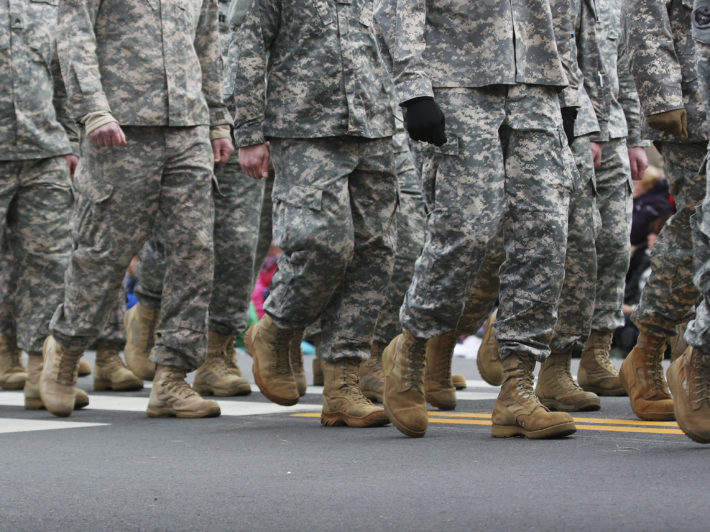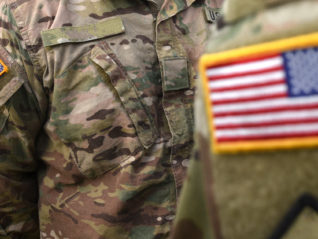
by Bianca Garilli, ND, IFMCP, USMC Veteran
Introduction
SARS-CoV-2 (COVID-19) began its destructive path in China in late 2019 and spread, quite literally, across the globe at speeds faster than most could have ever imagined. Worldwide, the COVID-19 virus has left (at the time of this writing) over 190,000 people dead, and nearly 2.7 million infected based on the limited testing that most countries have employed. And the trajectory of the global curve is still uncertain. The fight is real, the enemy microscopic, the future forever changed.1
One of the many groups greatly affected by the novel coronavirus, while also playing a major role in defeating this pandemic, is the United States military.
Send in the troops
On March 22, 2020, President Trump approved Title 32 activation of National Guard troops in three states: California, New York, and Washington in the fight against COVID-19.2 According to Title 32, Guard members serve within their home states under the direction of the governor, supporting the needs of their particular state. These Guard units regularly train for national emergency situations, frequently conducting training exercises alongside state and local emergency responders. With nearly 450,000 men and women across the nation, their knowledge and willingness to serve their country during this challenging time will be of tremendous support to the civilian healthcare sector. To date, a total of 38 states, three territories, and the District of Columbia have been approved for use of federal funds for state missions under Title 32; more requests are also being reviewed.3 Examples of activities the Guard will be undertaking include, “supporting drive-through testing sites, conducting food delivery to protect vulnerable populations, and helping states plan and coordinate their local responses;” they are also testing nursing home patients and staff, helping to collect deceased bodies, working at drive-through test sites, stocking and distributing food and supplies in warehouses across the nation, triaging inbound phone calls, manufacturing PPE, and, in West Virginia, even helping government officials process unemployment claims.3,4
National security and COVID-19
The ability to maintain national security during the COVID-19 pandemic is critical, particularly in light of the fact that the military is not immune to such an outbreak as can be seen by the steadily rising numbers of infections present in the active duty population.
As of April 21, 2020, there have been over 5,500 active COVID-19 cases connected to the DoD, with approximately 3,500 of those cases involving active duty military members; the remainder of cases involve government contractors, employees, or military family members.5,6 There have been 22 deaths reported throughout the DoD.5,6 These numbers are expected to rise in concert with the general population; however, true numbers may not always be available in order to maintain national security issues surrounding such information.
The silver lining for the military? Active duty military personnel typically fall into the young and fit category, hopefully resulting in fewer cases and deaths in this population. At this point, however, as with the entire globe, the how, who, why, when, and what of the SARS-CoV-2 seems a moving target, so only time will really tell.
What we do know is that from a military standpoint, troop readiness and national security will continue to be top priorities. The Vice Chairman of the Joint Chiefs of Staff, Air Force General John E Hyten noted, “We watch the readiness of the force every day. And the readiness of the force, in aggregate, has not dropped as we’ve gone through this. That’s something that we have to watch very, very closely.”7
One of the areas the military is watching closely is its pipeline—the recruitment process and training of new troops. Each branch of service is reviewing its recruitment needs and weighing it against the dangers and unknowns of the COVID-19 infection. Most of the services have taken their recruiting process to the virtual world, implementing online and telephonic recruiting processes.8,9
The services have each approached the pandemic and recruiting process differently:
- The Air Force has temporarily shortened its basic training course while also reducing group sizes to support social distancing guidelines.9
- The Marine Corps has temporarily suspended training at Parris Island, South Carolina, although bootcamp continues on the West Coast with modifications such as screening recruits for infection prior to arriving at boot camp, increasing distance between bunks in the squad bays and on the firing lines, increasing sanitization of squads and equipment, and eliminating the routine “leave” to visit families between graduation from bootcamp and presenting for duty at next location.10
- In the most dramatic of moves, the Army suspended shipping all new recruits to basic training for two weeks only just resuming basic training on April 20.11,12 Pentagon leaders noted concerns with this move as possibly impacting national security and readiness within the Army ranks for the short term even if restrictions were for a short period of time, or even for years to come if these changes are reimplemented in the future.12
Troop readiness & military innovation
In early March, Defense Secretary Mark Esper implemented a travel ban on all domestic and international travel and change of duty stations (PCS) for military personnel and their families through May 11; on April 18 these unprecedented restrictions were extended to June 30.13 The stop-movement orders are anticipated to impact hundreds of thousands of troops, civilian employees, and families stateside while likely affecting upward of 90,000 service members who had orders to deploy or return to various home stations from overseas during this time period.14,15
Additionally, the health protection condition levels at military bases worldwide were raised to the second-highest threat level, HPCON Charlie, on March 26, restricting large gatherings, adding temperature checks for personnel at building access points, and limiting base access to mission-essential individuals.14 Contingency response forces, those who are required to be ready to deploy with literally hours’ notice, have been placed on HPCON Delta in the hope they will be spared exposure and infection with COVID-19, enabling them to maintain troop readiness, anywhere, anytime.14
The military is also heavily involved in supporting the development of treatments and vaccines against SARS-CoV-2. Walter Reed Army Institute of Research in Silver Springs, MD, has launched preclinical trials focusing on the spike protein of the virus. In Fort Detrick, MD, at the US Army Institute of Infectious Diseases (USAMRIID), military experts are entrenched in various projects surrounding the virus, including developing an animal model that can be used to test possible treatments prior to reaching human clinical trials.16
Further south at the Naval Surface Warfare Center Panama City Division (NSWC PCD), the DoD initiated a “Hack-a-Vent Innovation Challenge” to bring together the best and most innovative minds to develop low-cost, easily-assembled, non-FDA-approved ventilators that could be rapidly prototyped and used in both hospital and field settings. The successful prototypes will be further developed in order to rapidly disseminate vents as needed throughout the nation as well as internationally.17
In light of these challenging times and the vast unknown, military personnel have “laced up their boots” and are facing the enemy eye to eye. They are taking extra precautions to mitigate the risk of exposure, isolating those infected or contagious as possible, and are maintaining focus on troop health, force readiness, and national security. The United States military has successfully and bravely fought in wars before; this will be no different.
Citations
- COVD-19 dashboard by the center for systems science and engineering (CSSE) at Johns Hopkins University (JHU). https://www.arcgis.com/apps/opsdashboard/index.html#/bda7594740fd40299423467b48e9ecf6. Accessed April 14, 2020.
- Trump authorizes title 32 activation of Guard in 3 states battling covid19. https://www.airforcemag.com/trump-authorizes-title-32-activation-of-guard-in-three-states-battling-covid-19/. Accessed April 9, 2020.
- Most National Guard troops deployed in fight against the coronavirus now on federal orders https://www.stripes.com/news/us/most-national-guard-troops-deployed-in-fight-against-the-coronavirus-now-on-federal-orders-1.626771. Accessed April 22, 2020.
- US Department of Defense; Coronavirus Rumor Control. https://www.defense.gov/Explore/Spotlight/Coronavirus/Rumor-Control/. Accessed April 9, 2020.
- WorldOMeter. https://www.worldometers.info/coronavirus/country/us/. Accessed April 22, 2020.
- Snapshot: DoD and COVID19 https://www.airforcemag.com/snapshot-dod-and-covid-19/. Accessed April 22, 2020.
- Despite COVID-19, US military remains ready to fight. https://www.defense.gov/Explore/News/Article/Article/2143506/despite-covid-19-us-military-remains-ready-to-fight/. Accessed April 9, 2020.
- Marine Corps recruiting stations are going virtual as COVID19 continues to disrupt the military. https://www.marinecorpstimes.com/news/coronavirus/2020/03/25/marine-recruiting-stations-are-going-virtual-as-covid-19-continues-to-disrupt-the-us-military/. Accessed April 9, 2020.
- COVID19 information. https://www.airforce.com/frequently-asked-questions/covid-19-faqs/. Accessed April 9, 2020.
- COVID-19 threat reshapes Marine boot camp; celebrations will have to wait. https://news.usni.org/2020/04/03/covid-19-threat-reshapes-marine-boot-camp-celebrations-will-have-to-wait Accessed April 9, 2020.
- U.S. Army to resume shipping recruits to basic training after two-week pause. https://recruiting.army.mil/News/Article-Display/Article/2156718/us-army-to-resume-shipping-recruits-to-basic-training-after-two-week-pause/. Accessed April 22, 2020.
- Army stops adding new recruits in coronavirus response. https://www.usnews.com/news/national-news/articles/2020-04-06/army-stops-sending-recruits-to-basic-training-in-coronavirus-response. Accessed April 9, 2020.
- DoD travel ban amid coronavirus pandemic extended to June 30. https://www.militarytimes.com/news/your-military/2020/04/18/dod-travel-ban-extended-to-june-30/. Accessed on April 22, 2020.
- Pentagon halts all overseas travel, increases restrictions at bases as coronavirus cases reach 600. https://www.stripes.com/news/us/pentagon-halts-all-overseas-travel-increases-restrictions-at-bases-as-coronavirus-cases-reach-600-1.623770. Access April 9, 2020.
- Pentagon adopts new domestic travel restrictions for troops to help stop spread of coronavirus. https://www.washingtonpost.com/national-security/2020/03/14/pentagon-adopts-new-domestic-travel-restrictions-troops-help-stop-spread-coronavirus/. Accessed April 9, 2020.
- The US Army’s virus research lab gears up to fight COVID-19. https://www.airforcemag.com/usaf-flies-first-covid-19-positive-patients-with-isolation-pods/. Accessed April 14, 2020.
- Military scientists, engineers develop ventilator prototype in response to COVID-19. https://health.mil/News/Articles/2020/03/27/Panama-City-scientists-and-engineers-develop-ventilator-prototype-in-response-to-COVID-19. Accessed April 14, 2020.
Bianca Garilli, ND, IFMCP is a former US Marine turned Naturopathic Doctor (ND). She works in private practice in Northern California and consults with naturopathic and Functional Medicine leaders, including the Institute for Functional Medicine and Metagenics. She is passionate about optimizing health and wellness in individuals, families, companies and communities- one lifestyle change at a time. Dr. Garilli has been on staff at the University of California Irvine, Susan Samueli Center for Integrative Medicine and is faculty at Hawthorn University. She is the creator of the Military and Veteran Health Initiative and is the current Past-President of the Children’s Heart Foundation, CA Chapter.






